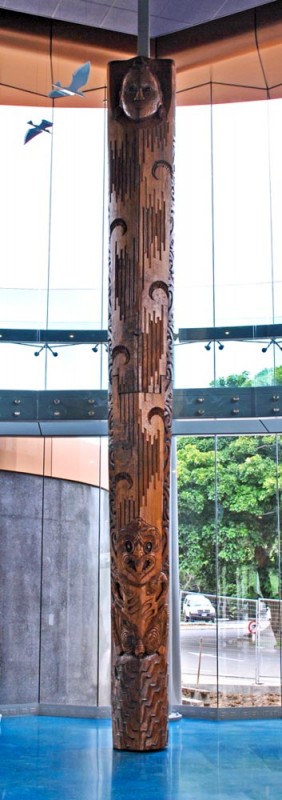
Te Ara Wairua Carved by Te Wānanga Whakairo Rākau-o-Aotearoa under the tutelage of Te Taonui-a-Kupe (James) Rickard Based on kōrero received from Pineaha Murray Carved in Totara, 2012
The Ngāti Kuri pou, “Te Ara Wairua” was carved by Te Wānanga Whakairo Rākau-o-Aotearoa under the tutelage of Te Taonui-a-Kupe (James) Rickard Based on kōrero received from Pineaha Murray. Carved in Totara, 2012.
Te Ara Wairua has been designed in the literal form of a pouwhenua, a form that symbolically acknowledges the laying down of kōrero, from its place of installation outward. The pouwhenua is a traditional weapon which predates other long staffs such as the taiaha. Its primary function was to claim the talking space on the marae atea.
Te Ara Wairua represents the spiritual pathway in two layers: the pathway of humankind into the after world as represented by Hinenuitepō (at the base of the pou whenua) and the omnipresent kaitiaki, represented by Waipapakauri and the additional twelve kaitiaki, stylised as manaia down each side of the carving.
Waipapakauri is an ancient kaitiaki. His presence in Aotearoa predates human arrival here. He is adorned with symbols of arikitanga (high chieftanship). He is represented with four Huia feathers and a huia bird hung from each ear. The Huia was a highly valued bird across all tribal areas, to the point, highly valued carved boxes (waka huia) were used to store the feathers – usually in the rafters of a chiefs house.
Waiapapakauri also wears a moko kuri. Moko kuri is a moko tawhito (ancient design) which predates the geometric design seen in abundance today. The design is based on the concept of a dog scratch and is composed with vertical and horizontal cuts. The cuts start and end shallow and are deeper in the middle to resemble the scratching motion of a dog.
The central pakati and haehae designs represent the departing spirits as seen at pa**** tū ana ngā tai (the clashing oceans). The base of the carving is designed with the corrugated sands of the Parengarenga harbour and the whare tangata of Hinenuitepo is represented by a Pupuharakeke. These elements are depicted to represent the unique features of the Muriwhenua and the environs of Ngāti Kuri.

